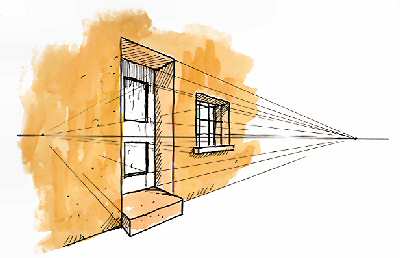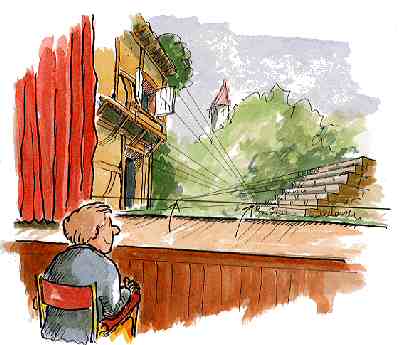SCENERY PAINTING
FOR THE AMATEUR MUSICAL THEATRE and PANTOMIME |

Most people can grasp the basics of flat plane perspective such as looking under a table; seeing the edge thickness of a door frame, or looking down on a door step, but up under a lintel.
The drawing on the left shows the horizontal Eye-line and the construction lines merging at the two vanishing points. (left and right).
First of all a word about the name EYE LINE. It is often also called the HORI ZON LINE and both refer to the same geometric construction line. However, I prefer " Eye line" as that word “Horizon” appears to assume you are referring to the actual horizon. This is not necessarily the case - especially if you are amongst mountains when the perspective "Horizon Line" might be nowhere near the horizon of the mountain range.
Eye line or Horizon line - your vanishing points will be plotted along this line.
In theatres with raked (sloping) seating in theory only one row of the audience will see the sets correctly if you slavishly stick to perspective rules. And to be pedantic only one of those seats will see it as you had planned, becasue thicknesses of windows/doors frames etc. will 'move' depending upon the angle from which they are viewed. In real life, as we walk about together, we each see a slightly different view of the same scene. (As we also all see a different rainbow) But of course in the theatre all the audience is presented with your same scene.
Historically when painting cloths/flats in correct perspective, the Eye Line used to be set at the same height as the "Royal Box" There aren't many Royal Boxes about in school halls these days where our scenery is going to be seen, so where do you pitch your line? Well I usually have a different line for each scene! You'll be the only person who knows that.... The audience (and cast) never seem to notice in any case.

Usually in school assembly halls the stage is about 4 feet off the ground. This means that the audiences' "eye line" comes a few inches up from the bottom of the scenery. Not a happy placing, but can be used effectively for certain scenes.
The drawing on the left shows the eye-line at the audiences' "eye line" with two vanishing points arrowed. One for the steps and one for the cottage.